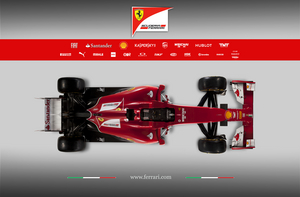|
Send this page to a friend! Fill in the form bellow | ||
news
Ferrari unveils new F14 T for the 2014 F1 season
Rule changes forced the team to revise every aspect of the car's design
After unveiling on Friday that its' F1 car for 2014 would be called F14 T Ferrari F14 TItaly, 2014 > 2014, Ferrari
Ferrari F14 TItaly, 2014 > 2014, Ferrari FerrariItaly, 1947 > present233 models
FerrariItaly, 1947 > present233 models
5131 photos
37 videos
has unveiled the design of its sixtieth car to take part in the Formula 1 World Championship. The name comes from the combination of the current year and the introduction of the turbo-compressor in the Power Unit and was hosen online by Ferrari's fans.
Because of the enormous changes in rules for this season, the current design, which goes by the internal code name 665, started being developed more than two years ago. 2014 is an exceptional year in the history of the sport that commanded an early start to allow the ground up revision of every aspect of the car’s design.
Chassis
We can still find some inspirations with earlier Ferrari designs in the F14T, however most of the car has nbeen completely redesigned. Externally, the car is very different to the cars of recent years and the lower chassis and nose, mandated by the new rules for more safety, give the F14 T a very different appearance to the F138 Ferrari F138Italy, 2013 > 20138 photos
Ferrari F138Italy, 2013 > 20138 photos
. Engineers faced a real challenge to repackage the front suspension into a much lower monocoque.
The 2014 rear wing family shares nothing with the previous year owing to three rule changes requiring a much larger stroke DRS, a much smaller overall rear wing depth and removal of the beam wing, thereby requiring the main plane to be supported by central pillars.
The front wing is regulated to be 75mm narrower per side in order to make it less vulnerable to collisions with other cars and with the barriers. This change has a profound effect on the aerodynamics of the vehicle. This change of just 75mm to the position of the wing has forced Ferrari to reinvent completely the front wing aerodynamics for 2014.
Integration
The new car has completely different cooling requirements from any of its predecessors. Engine oil and water radiators shrink in size to match the relatively smaller V6 internal combustion part of the Power Unit. However, new homes had to be found to accommodate an intercooler for the turbo-compressor system and to manage heat rejection from ERS components that are many times greater than their KERS antecedents. Given that more cooling allows more horsepower, but more cooling also damages downforce generation it was necessary to decide very carefully on the correct level of overall cooling for the car to render the best lap time compromise between horsepower and downforce.
Transmission
The 2014 Power Units produce greater peak power than their 2013 counterparts and do so at lower RPM with higher torque. The F14 T transmission has been designed with the aim of ensuring that the team continues to enjoy highly efficient delivery of power through the drivetrain while producing class leading starts and high levels of reliability.
Driver lineup
The 2014 season marks the return of Kimi Raikkonen to Ferrari, a driver that was World Champion with the team in 2007. The Finn is back and will be Alonso's team-mate, after the dismissal of Felipe Massa. Ferrari will hope that these two very experienced drivers will be able to bring the team back to the titles, which have been escaping since 2007.
Encyclopedia |
Contribute
more about Ferrari



latest news














